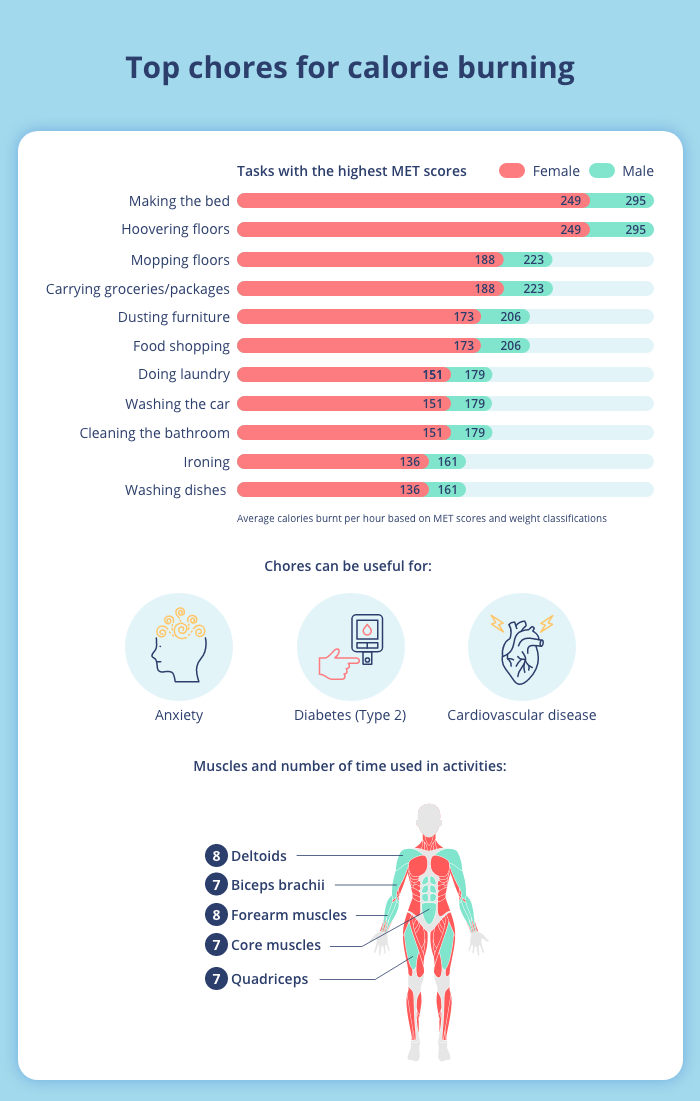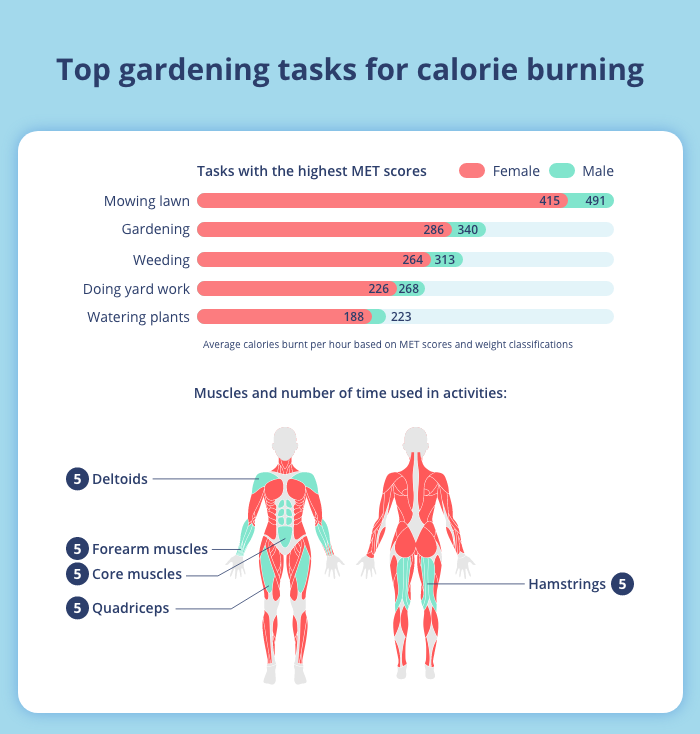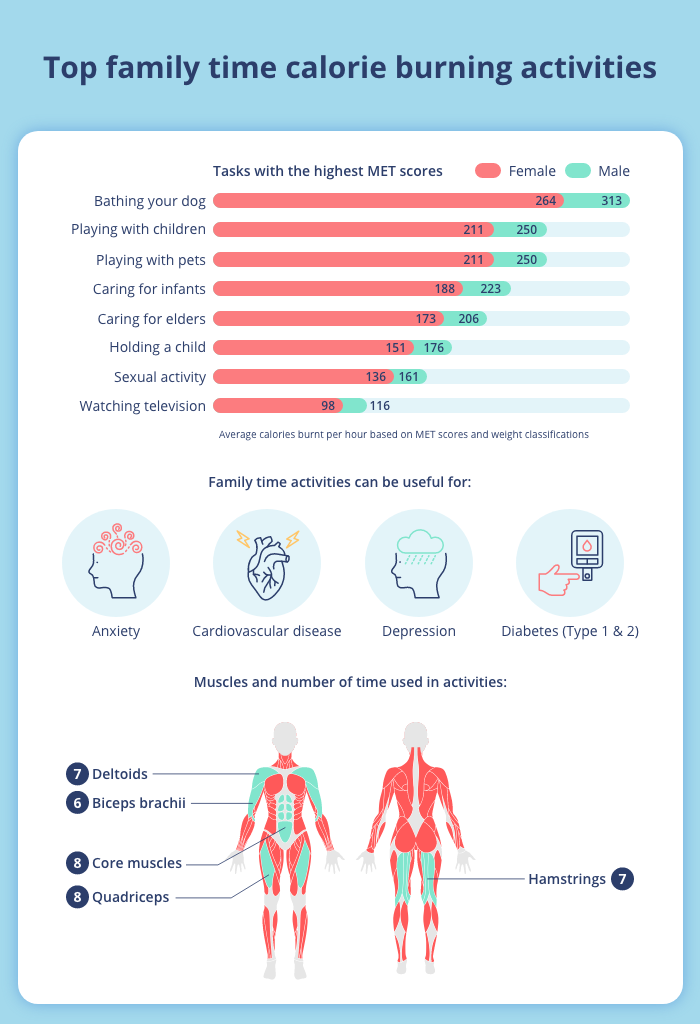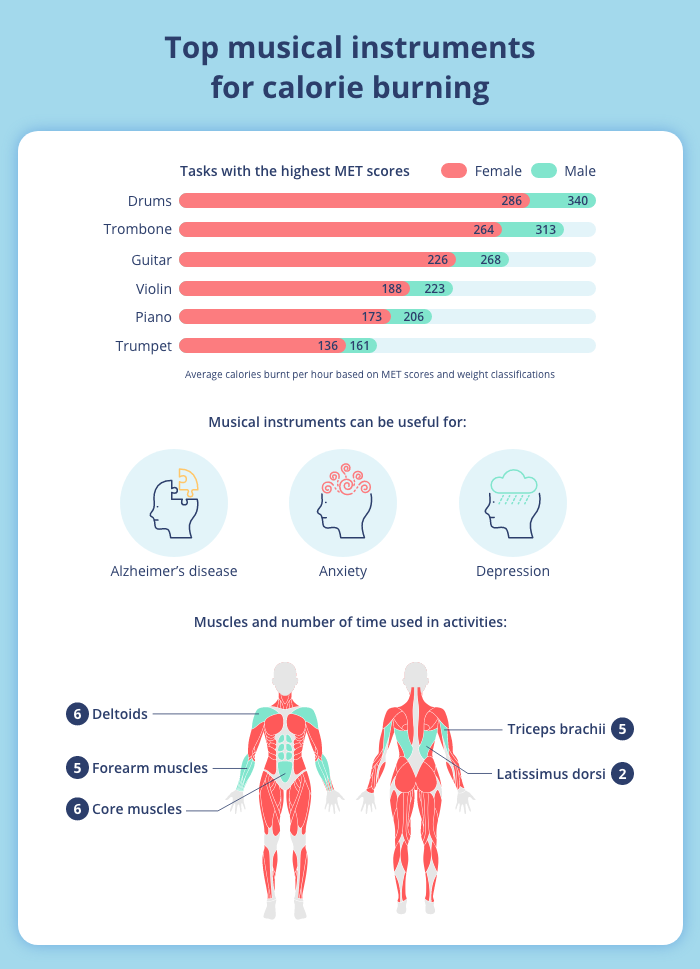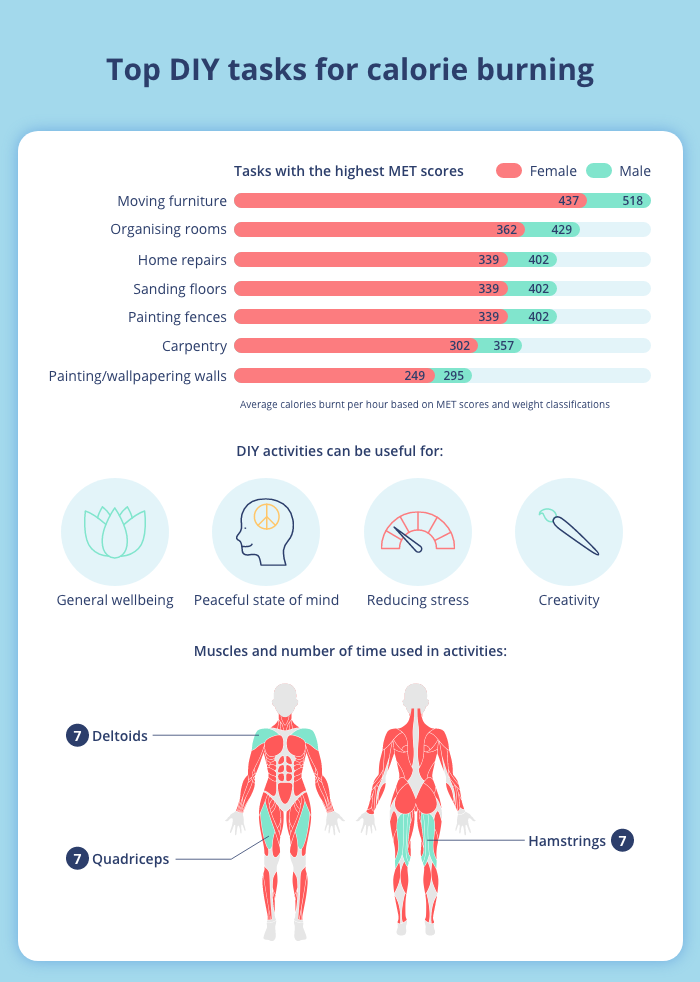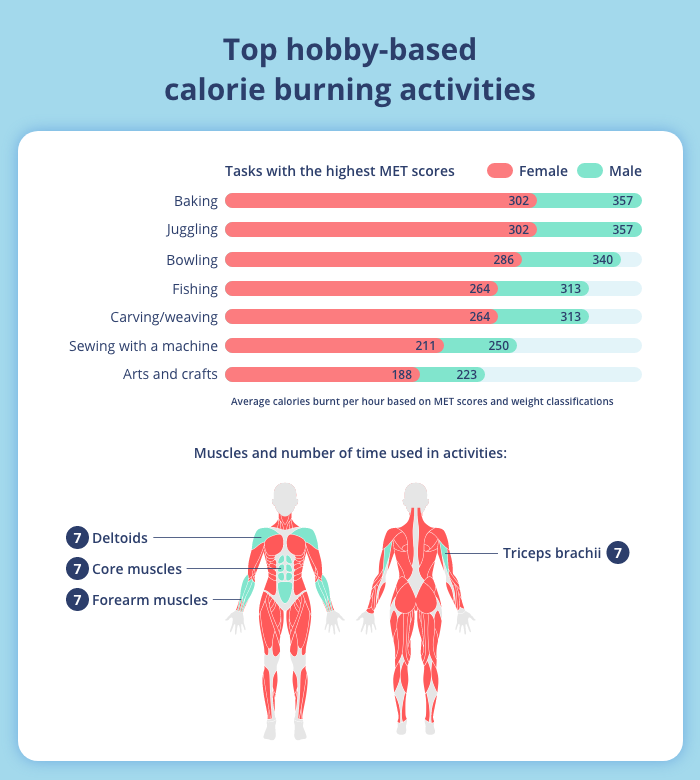The surprising ways you’re burning calories every day
Reviewed by Dr Neel Patel
The regularity of the gym and structured exercise routines certainly have their merits. But the truth is, we expend far more energy in our day-to-day activities than we might realise.
In this article, we explore beyond the confines of the fitness centre and discover the calorie-burning wonders of ordinary activities. From household chores and gardening to spending time with family, a healthier lifestyle doesn't always require a gym membership.
Our research
MET (metabolic equivalent of task) scores from the Physical Activity Compendium tell us that many exercises have similar calorie-burning capabilities to daily activities. For example, one hour of power yoga burns roughly the same calories as one hour of baking. According to the NHS’s average weight of British men and women, this is 357 and 302 calories, respectively, for both activities.
To find out more, the experts at LloydsPharmacy Online Doctor conducted a study where we monitored the calories burned by participants completing various household chores and compared these to their expected calories burned according to the MET score to calorie formula.
We also teamed up with personal trainer Lauren Knott, to share physical health and exercise tips to support expert advice from our leading clinician, GP, Dr Neel Patel.
Traditional exercise vs daily tasks
Traditional sports and exercises burn more calories than daily chores, hobbies and other activities. However, the difference between the two might be less than you expect.
Our data shows that an hour of moving furniture or mowing the lawn might have more calorie-burning potential than the same time spent on a stair treadmill or rope skipping. While these daily tasks might not feel like exercise, they can have significant health benefits that are often overlooked.
Therefore, if you have weight loss goals you’re trying to achieve, improving your activity levels through everyday activities such as DIY, spending time with loved ones and gardening may be the best place to start.
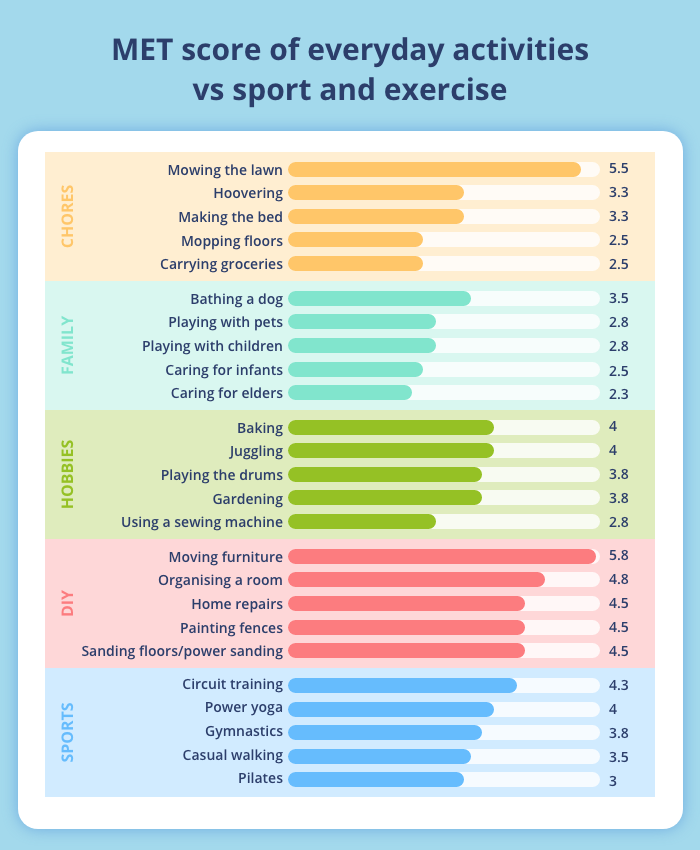
Chores
Household chores are often considered an inconvenience. However, we found that simple tasks like hoovering, mopping, and changing bedding may help burn as many calories as traditional exercise.
Concerning MET scoring, these chores almost equal walking and can burn more calories than a pilates session if performed for an hour.
1. Making the bed
This quick and straightforward daily task burns a surprising amount of calories. If you were to spend 10 minutes making your bed every morning, you would burn just as many calories as if you were hoovering the house or going for a quick 10-minute walk.
Lauren says: "Making the bed is a great way to start your morning, engaging different muscles and allowing you to get a good stretch in before you start your day.”
2. Hoovering
This essential chore is our joint highest-ranked for burning calories. In our study, the average male participant burned an incredible 295 calories an hour when hoovering, while the average female participant burned 249 calories in an hour.
Lauren says: “Hoovering can be great exercise. Not only are you burning calories through movement, but you’re also building muscle. Every push of the hoover activates the biceps, and every pull activates the triceps, making it a great arm workout.”
3. Carrying
Lauren says: “While not a task you might think about very often, plenty of carrying occurs in our daily activities, from carrying groceries and washing to moving furniture. To make carrying more engaging, add squats to give your legs a real workout, or include shoulder shrugs to work your traps.”
Men burn an average of 223 calories an hour during household carrying, while women burn 188; this can be a great way to activate your core and leg muscles, as long as you lift with your legs and not your back.
Dr Neel Patel says: “Not only are household chores incredible for burning calories, but they can also help our cognitive health. Studies have identified that housework increases cognitive function among older adults. Regardless of the intensity of the housework, doing household chores was associated with higher global cognition. Housework has also been related to reduced risk of multiple types of dementia, and high-intensity housework was associated with a 14% higher attention score."
Gardening
Gardening is a great way to burn calories, get outside, and enjoy more sun exposure. Generally considered manual labour, gardening has often been regarded as an intense activity, depending on the task.
1. Mowing the lawn
No access to a pool? No worries. If you have a garden, mow the lawn for one hour, and you may burn more calories than swimming breaststroke for an hour.
Lauren says: “If you want to work out your legs while you mow, add walking lunges to your activity to target your glutes and quads.”
On average, men burn 491 calories an hour when mowing the lawn, while women burn 415.
2. Moderate-effort gardening
Lauren says: “Non-specific activities in the garden can burn more calories than expected. Gardening might include pruning, repotting, strimming or planting. Light gardening is also beneficial for back pain, as it can help loosen the muscles.
To turn pottering around the garden into a workout, use gardening equipment as weights and add some bicep curls. You can do this simple exercise with a light to moderate weight and feel the benefits after just a few repetitions.”
Our study discovered the average man burns 340 calories an hour while doing general gardening tasks, while the average woman burns 286.
3. Weeding
Anyone who has weeded their garden knows it can take a lot of energy. Weeding involves a lot of movement, bending and strength, depending on how deep each weed is rooted.
Lauren says: “Add squat holds while weeding for extra benefits. By squatting and holding while you pull weeds from your garden, you work your legs and protect your back since you won’t be hunched over while picking weeds.”
We found that the average man burns 313 calories per hour when weeding the garden, while the average woman burns 264 calories per hour.
Dr Neel Patel says: “There are many other benefits of gardening, and green spaces boost well-being. Research has identified that people who lived closer to green spaces reported less mental distress.
“Gardening will also boost people’s vitamin D intake as they are more exposed to sunlight, helping the body maintain strong muscles. Just ensure that you’re wearing adequate SPF sun cream to protect your skin.”
Family time
Whether your family consists of a spouse and children, a partner, your parents or a pet, spending quality time together can benefit your health and well-being.
1. Pet bathtime
If you’re not burning calories bathing your pet, you might have the world’s most relaxed four-legged friend. For dog and cat owners with more energetic companions, bathtime can be a workout.
Lauren says: “If your pet is making bathtime easy and you want to add exercise, try squats next to the bath to work out your glutes and quads while washing up your furry friend.”
We found that the average man burns 313 calories an hour when bathing their dog, while the average woman burns 264.
2. Playing with children or pets
Lauren says: “Playtime with your children or pets can be a fantastic bonding experience. Plus, play can burn almost as many calories as an hour of Pilates.
Running around the garden or the park can be a great way to raise your heart rate and burn extra calories. As well as exercising, you’ll make memories and have a lot of fun!”
Our study found that, on average, a man burns 250 calories an hour playing with children or pets, while women burn 211 calories.
3. Childcare
Lauren says: “Looking after an infant can be incredibly energy-consuming. Even small tasks, like carrying a baby, changing nappies, feeding and soothing, all accumulate – I’m sure anyone who’s cared for an infant can attest to that.
Taking infants out for a walk is an additional way to incorporate exercise into childcare. It can help burn more calories and let you relax together and enjoy the fresh air.”
On average, men burn 223 calories an hour caring for an infant, while women burn 188.
Dr Neel Patel says: “Activities that don’t seem difficult can still burn calories and have other benefits beyond the number on the scale.
“Playing with children burns calories and increases family time, which is associated with more vital emotional support to help you both navigate life’s challenges. It can also reduce anxiety and depression. Research shows that fewer activities and rituals (like eating as a family) can result in higher mental health complaints from parents and youngsters.
“Owning a pet is a great way to burn calories. It increases movement (walking a dog), and there are other health benefits. Studies of owning a pet have shown a significant reduction in the risk of death, with reductions in all-cause mortality. A meta-analysis discovered that dog ownership reduced the risk of cardiovascular death by 31%.
“Pet ownership also provides an opportunity for reduced mental health issues, with reduced anxiety and an external focus of attention. Pets can also decrease feelings of loneliness and depression.”
Instruments
Interestingly, playing a musical instrument is beneficial for burning calories and can therefore contribute to a calorie deficit. Many require much movement to play and more to perform, making the hobby an ideal way to burn calories while having fun.
1. Drums
It might not be a surprise that drums are the most physically active instrument to play, involving the movement of arms and legs at a constant pace. If you’ve seen any band live, you’ll know how much energy drummers put into their set and how quickly that can build up a sweat.
Lauren says: “Playing the drums is already an exercise, but if you want to burn extra calories, increase the song's BPM to move more quickly.”
According to our study, on average, a man burns 340 calories per hour playing the drums, while a woman burns 286.
2. Trombone
This brass instrument takes a lot of breathwork to control. Unlike most brass instruments with valves, the trombone uses a long slider to alter its pitch, which the musician controls, requiring a lot more bicep and tricep action to play.
Lauren says: “A fun way to add exercise to this skill is by including knee raises and pretending you’re in a marching band. By doing this, you’ll be activating your hip flexors and abs.”
We found that, on average, a man playing the trombone burns 313 calories an hour, while a woman burns 264.
3. Guitar
Favourite instruments of rockstars and teenagers worldwide, the humble guitar may help you burn calories while you jam. Of course, the more performative you play, the more calories you burn.
Lauren says: "To turn this into an exercise, pretend to be a real rockstar and show off to your fans. You can use your guitar as a weight to perform bent-over rows and shoulder presses.”
Our study found the average man playing the guitar standing burns 268 calories an hour, while the average woman playing the guitar burns 226 calories.
Dr Neel Patel says: “Musical instruments are fun to play and can provide many other benefits.
“A big benefit is using music as an intervention tool for people with Alzheimer's and dementia. Musical training provides a multisensory activity that requires signals with motor responses, training the brain. The actions of playing an instrument in older adults improved the brain's executive functioning (abilities and behaviours).”
DIY
Performing DIY tasks around the house may burn more calories than you may first expect. Not only will you be able to improve your home, but you can also improve your health.
1. Moving furniture
As nice as it is to have a new sofa or bed delivered, we all dread the process of moving the old one out and the new one in. Luckily, you can treat this task as a fully-fledged workout since it burns so many calories.
Lauren says: “Moving furniture is amazing for your biceps, hamstrings, and quads. Just make sure to lift heavy items with your legs and not your back to avoid injury.”
We found that, on average, men burn 518 calories per hour while moving furniture, while women burn 437 calories.
2. Organising rooms
Revamping your room can provide a great deal of exercise while also improving your general well-being. Our study shows that men burn 429 calories per hour and women burn 362 calories per hour while organising rooms.
Lauren says: “To enhance this task, you can treat smaller objects as weights to perform bicep curls or shoulder presses.”
3. Home repairs
Repairing your home can be somewhat of a stressful task. However, doing these repairs can help improve your fitness. On average, we found that men burn 402 calories per hour while doing home repairs, while women burn 339 calories per hour respectively.
Lauren says: “If you really want to make this into a workout, you can add in some squats or lunges to target your quads and glutes.”
Hobbies
Enjoying personal hobbies is a great way to get up, burn calories and become healthier. Even baking is a physical activity that can burn as many calories as an hour of power yoga.
1. Baking
Lauren says: “Baking burns a surprising number of calories and can be a great workout for your triceps. However, you’ll only be burning those calories if you’re doing everything by hand and avoid electronic mixers.”
According to our study, on average, men burn 357 calories when baking, while women burn 302 calories an hour.
2. Juggling
Lauren says: “While not an easy hobby to get into, juggling can burn a lot of calories if you take the time to learn how. Juggling can provide a real forearm workout as well as improving your dexterity and hand-eye coordination.”
On average, men burn 357 calories an hour when horseback riding, while women burn 302 calories.
3. Bowling
Lauren says: “Bowling can burn calories while providing entertainment. Carrying a heavy bowling ball activates your core muscles and the motion of bowling can stretch your arms and legs.”
Our study found that men burn 340 calories an hour on average moving furniture, while women burn 286 calories.
Exercise alternatives
Traditional exercise isn’t for everybody. While many of us don’t enjoy training for personal reasons, some people can’t perform specific movements due to disability, illness, age, or mental health reasons. But there are plenty of other fun ways to burn calories. Coupled with healthy eating, this can result in a calorie deficit leading to fat loss as the body starts to tap into its fat reserves.
Walking
If walking isn’t for you, you can choose many alternative activities that burn the same number of calories.
Lauren says: “Walking is a great exercise for those who can, whether walking in the park, to work, or even on a treadmill after a workout. But it’s not for everyone. Some people struggle walking long distances for age or health reasons, so we must identify hobbies that include all abilities.”
Fishing
Lauren says: “If you enjoy the outdoor element of walking but don’t want the leg movement, fishing could be a great alternative. Just like walking, fishing can burn 313 calories an hour for men and 264 calories an hour for women. Fishing can be great if you want to work the muscles in your upper body and for a sense of achievement when you finally get a bite!”
Weaving or carving
Lauren says: “If you enjoy the calming repetitiveness of walking but don’t want to go outside, you can burn just as many calories an hour by weaving or carving. These are great activities for creative people, letting you achieve the same activity as walking while weaving a basket or carving a wooden figure.”
Power Yoga
Power Yoga is a more fast paced style of yoga that focuses on strength and endurance, however, the activity can be a struggle for those with mobility issues. Luckily, alternative activities burn just as many calories an hour.
Baking
Lauren says: “Baking is a very active hobby, with lots of upper body strength needed for mixing and kneading. One hour of baking can burn 357 calories for men or 302 calories for women, the same as during an hour of power yoga. The one caveat: you’ll still gain calories if you eat the delicious cakes, cookies or bread you’ve baked so I’d encourage you to stick to a healthy diet."
Juggling
Lauren says: “If you’re looking for something more fast-paced, juggling can be a fun alternative. One hour of juggling burns the same calories as Power Yoga and can help improve your hand-eye coordination, agility and reflexes."
Activities for those with common illnesses
Sometimes illnesses can prevent people from engaging in certain traditional exercises which would usually aid in improving their physical and mental health. In these cases, finding alternative methods of being active becomes even more important.
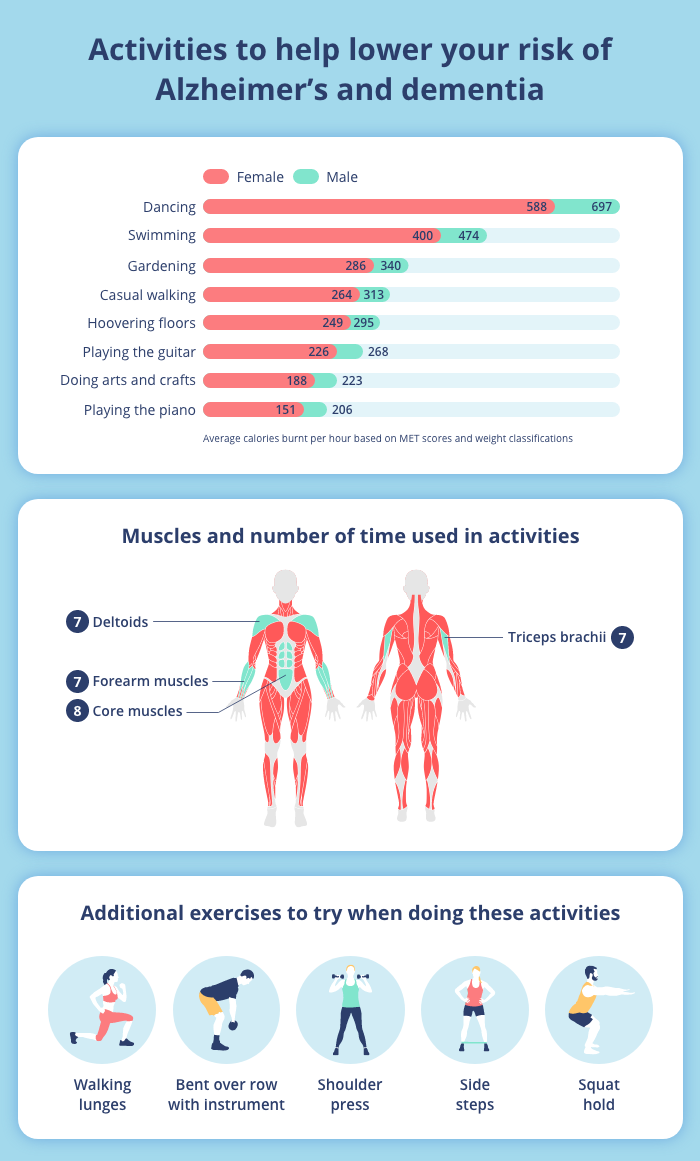
Playing a musical instrument can have a large variety of health benefits. A big benefit is the inclusion of music as an intervention tool for Alzheimer's Disease and dementia. The actions of playing an instrument in older adults improved the brain's executive functioning, providing a multisensory activity that requires signals with motor responses (van der Steen et al, 2018).
Housework has also been related to reduced risk of multiple types of dementia.
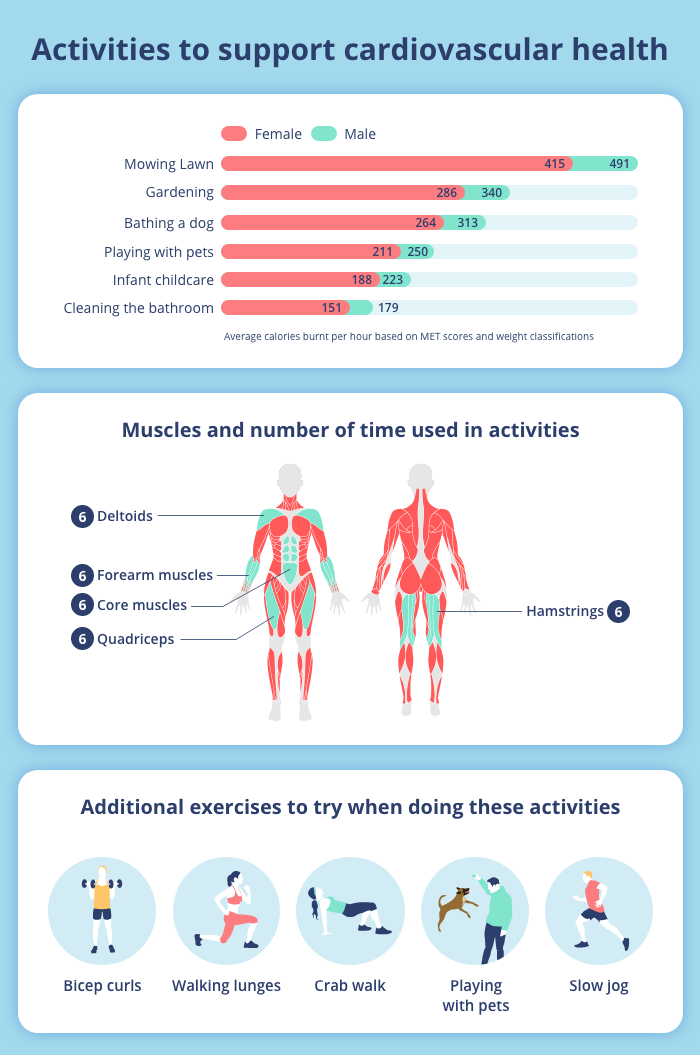
Gardening is associated with better cardiovascular health status. A study in Japan, showed that domestic gardening was also beneficial to the elderly, with positive effects on subjective happiness and habits around physical exercise and diet (Machida, 2019).
Studies on owning a pet have shown a significant reduction in the risk of death, with reductions for all-cause mortality. In a meta-analysis, it was discovered that dog ownership reduced the risk of cardiovascular death by 31%.
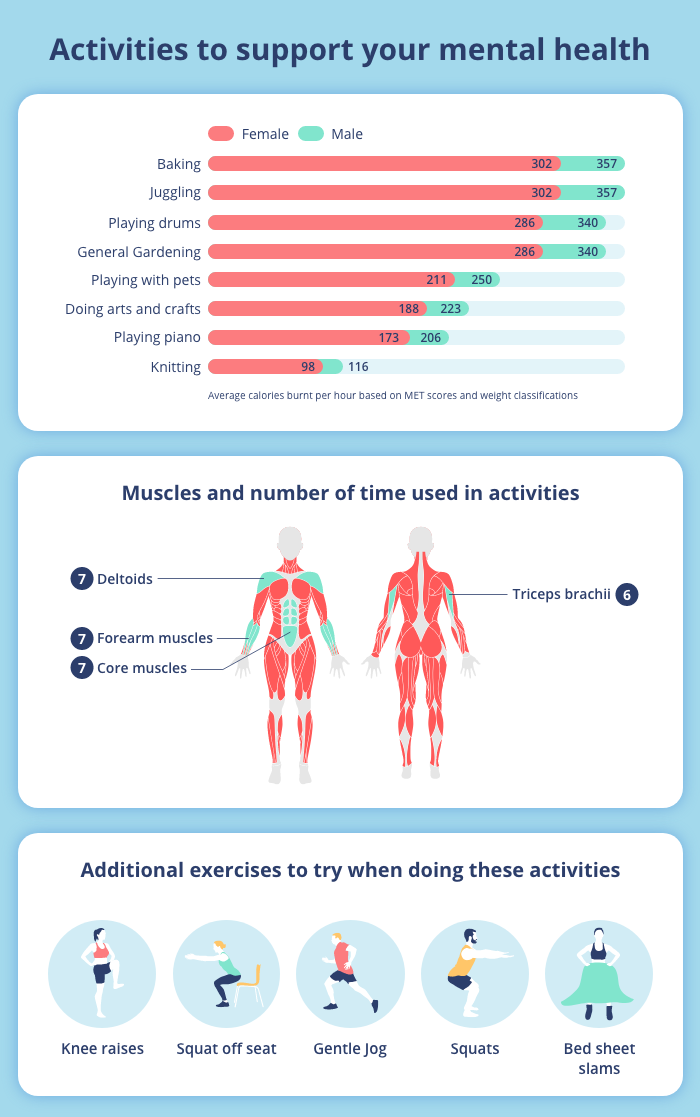
Learning to cook and bake has shown evidence of positive psychological outcomes. Studies have reported a positive association between cooking and self-esteem, decreased anxiety and an increase in quality of life.
Domestic gardens have been linked to reductions in social, emotional and behavioural difficulties in children aged four to six (Richardson et al., 2017), better physical and mental well-being in middle-aged and older people (Machida, 2019; Peeters et al., 2014), and a reduction in the incidence of depression in older people.
Studies have also identified that playing the piano can lower cortisol levels and decrease a person's anxiety levels. Interestingly, juggling has also been shown to help manage stress and is effective in helping with anxiety.
Not everyone burns calories at the same rate
The MET score lets us estimate how many calories we will burn for each activity, but there are lots of varying factors that affect this. We conducted a study monitoring the calories burned by 14 participants completing various household chores and compared these to their expected calories burned according to the MET score formula.
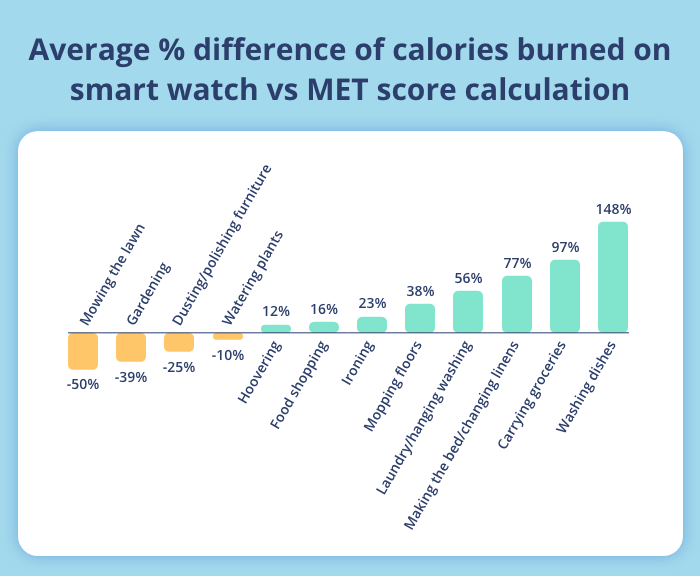
The results showed washing the dishes burned 148% more calories on average than the MET score predicted for our participants. In fact, 8 out of the 12 chores in the study burned more calories on average than predicted, including two of our top chores of hoovering and making the bed.
Mowing the lawn was revealed to burn 50% fewer calories for our participants than predicted by the MET score. The differences in how fast each participant burns calories, due to metabolism and muscle mass, will affect results, as will differences in the size and weight of lawn mowers used, and the shape of the garden.
By looking at each individual task and participants' results, we can see the study frequently achieved similar results to predicted MET score calories, with hoovering, mopping the floor and food shopping being the activities that repeatedly appear with the least variance.
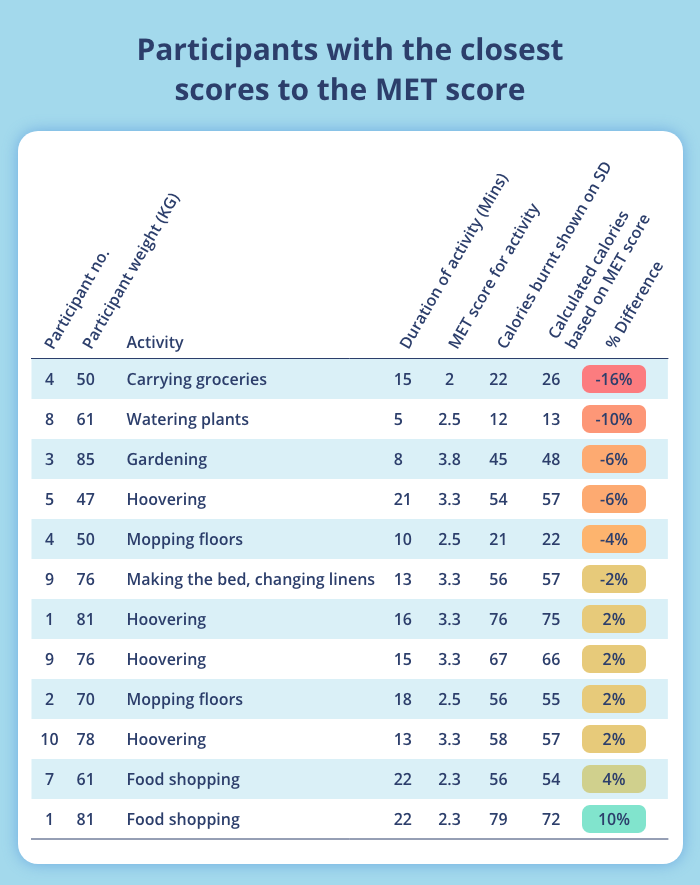
Our study showed that although the MET score can predict which activities are great to incorporate as additional exercise into your daily lives, how effective they are is down to your personal health and the effort and movement you put into completing them.
Methodology
Using the Compendium of Physical Activities, we identified activities that were not generally considered exercise but burn more calories than sitting still, ranging from household chores to gardening.
Using the MET scores of each physical activity, we were able to calculate the calories burnt using the following formula:
METs x 3.5 x (your body weight in kilograms) / 200 = calories burned per minute
1L of oxygen consumed = 5 calories. 1/5 = 0.2 (in this case, it’s 200 because it’s mL)
From this, we identified how many calories would be burnt every 60 minutes for every activity for the average weight of a male and female. We also calculated the calories burnt for underweight and obese males and females.
Average male and female weights were taken from NHS data. Parameters for under/overweight are based on the BMI scale.
We can identify everyday exercise equivalents to actual exercise and sport using these calorie calculations.
We worked with qualified PT Lauren Knott to identify the muscles each activity uses, and to suggest additional exercises. LloydsPharmacy Online Doctor’s Dr Neel Patel provided expert insight and comments on additional benefits of each activity, as well as advising which common illnesses and injuries the activities are suitable for.
We conducted an internal study to compare MET calculations with calorie consumption calculated on smartwatches. The sample size we used was 14 participants of varying weight and gender. Each participant was asked to perform household chores/tasks from a list wearing some form of smartwatch (various brands). The participants could do as many tasks or as few as they liked and record the calories they burned for the duration of the activity and step count. We obtained the weight of each of the participants and used this information to calculate the calories burnt using the MET score for the same duration the participants did the specified tasks. We then compared the two against each other to see any trends/differences.
Weight loss treatment
Need help losing weight? LloydsPharmacy Online Doctor can prescribe weight loss treatments to support you on your journey. Depending on your circumstance, our clinicians may recommend weight loss pills like Orlistat and Xenical or weight loss injections, Saxenda® and Wegovy®.
LloydsPharmacy Online Doctor are a safe prescriber which means a clinician will carry out a confidential consultation to assess whether a treatment is suitable. BMI and ID checks are required.
References
https://www.ncbi.nlm.nih.gov/pmc/articles/PMC5862744/
https://www.ncbi.nlm.nih.gov/pmc/articles/PMC6513122/
https://paintedbrain.org/blog/why-playing-a-musical-instrument-benefits-your-mental-health
https://pubmed.ncbi.nlm.nih.gov/31592726/
https://www.sciencedirect.com/science/article/abs/pii/S1744388117303584
https://n.neurology.org/content/99/8/e799
https://bmjopen.bmj.com/content/bmjopen/11/11/e052557.full.pdf
https://jech.bmj.com/content/56/2/89.short
